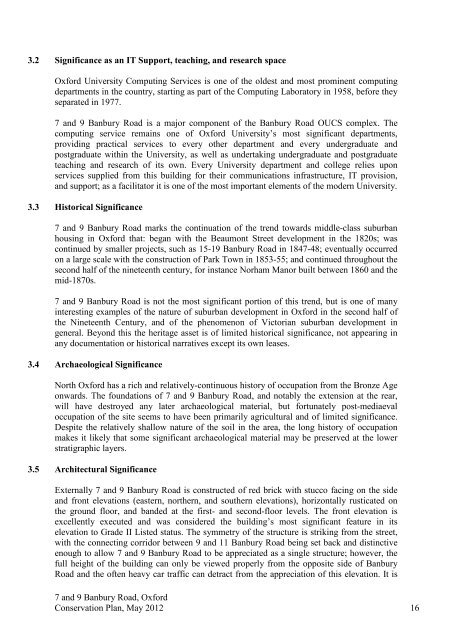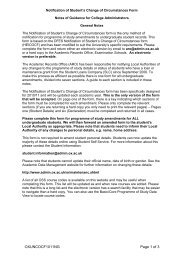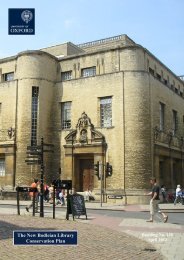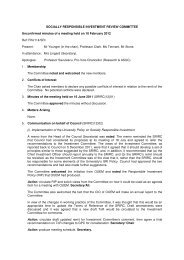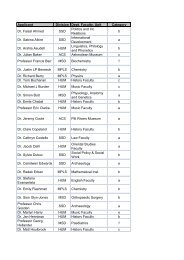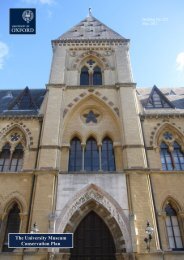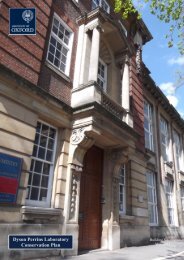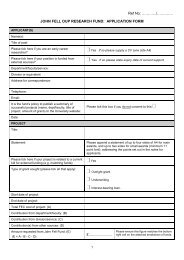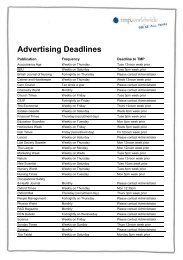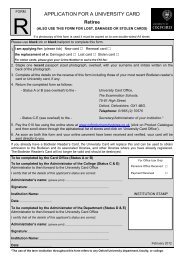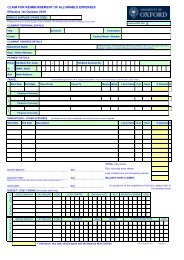7-9 Banbury Road - Central Administration - University of Oxford
7-9 Banbury Road - Central Administration - University of Oxford
7-9 Banbury Road - Central Administration - University of Oxford
You also want an ePaper? Increase the reach of your titles
YUMPU automatically turns print PDFs into web optimized ePapers that Google loves.
3.2 Significance as an IT Support, teaching, and research space<strong>Oxford</strong> <strong>University</strong> Computing Services is one <strong>of</strong> the oldest and most prominent computingdepartments in the country, starting as part <strong>of</strong> the Computing Laboratory in 1958, before theyseparated in 1977.7 and 9 <strong>Banbury</strong> <strong>Road</strong> is a major component <strong>of</strong> the <strong>Banbury</strong> <strong>Road</strong> OUCS complex. Thecomputing service remains one <strong>of</strong> <strong>Oxford</strong> <strong>University</strong>’s most significant departments,providing practical services to every other department and every undergraduate andpostgraduate within the <strong>University</strong>, as well as undertaking undergraduate and postgraduateteaching and research <strong>of</strong> its own. Every <strong>University</strong> department and college relies uponservices supplied from this building for their communications infrastructure, IT provision,and support; as a facilitator it is one <strong>of</strong> the most important elements <strong>of</strong> the modern <strong>University</strong>.3.3 Historical Significance7 and 9 <strong>Banbury</strong> <strong>Road</strong> marks the continuation <strong>of</strong> the trend towards middle-class suburbanhousing in <strong>Oxford</strong> that: began with the Beaumont Street development in the 1820s; wascontinued by smaller projects, such as 15-19 <strong>Banbury</strong> <strong>Road</strong> in 1847-48; eventually occurredon a large scale with the construction <strong>of</strong> Park Town in 1853-55; and continued throughout thesecond half <strong>of</strong> the nineteenth century, for instance Norham Manor built between 1860 and themid-1870s.7 and 9 <strong>Banbury</strong> <strong>Road</strong> is not the most significant portion <strong>of</strong> this trend, but is one <strong>of</strong> manyinteresting examples <strong>of</strong> the nature <strong>of</strong> suburban development in <strong>Oxford</strong> in the second half <strong>of</strong>the Nineteenth Century, and <strong>of</strong> the phenomenon <strong>of</strong> Victorian suburban development ingeneral. Beyond this the heritage asset is <strong>of</strong> limited historical significance, not appearing inany documentation or historical narratives except its own leases.3.4 Archaeological SignificanceNorth <strong>Oxford</strong> has a rich and relatively-continuous history <strong>of</strong> occupation from the Bronze Ageonwards. The foundations <strong>of</strong> 7 and 9 <strong>Banbury</strong> <strong>Road</strong>, and notably the extension at the rear,will have destroyed any later archaeological material, but fortunately post-mediaevaloccupation <strong>of</strong> the site seems to have been primarily agricultural and <strong>of</strong> limited significance.Despite the relatively shallow nature <strong>of</strong> the soil in the area, the long history <strong>of</strong> occupationmakes it likely that some significant archaeological material may be preserved at the lowerstratigraphic layers.3.5 Architectural SignificanceExternally 7 and 9 <strong>Banbury</strong> <strong>Road</strong> is constructed <strong>of</strong> red brick with stucco facing on the sideand front elevations (eastern, northern, and southern elevations), horizontally rusticated onthe ground floor, and banded at the first- and second-floor levels. The front elevation isexcellently executed and was considered the building’s most significant feature in itselevation to Grade II Listed status. The symmetry <strong>of</strong> the structure is striking from the street,with the connecting corridor between 9 and 11 <strong>Banbury</strong> <strong>Road</strong> being set back and distinctiveenough to allow 7 and 9 <strong>Banbury</strong> <strong>Road</strong> to be appreciated as a single structure; however, thefull height <strong>of</strong> the building can only be viewed properly from the opposite side <strong>of</strong> <strong>Banbury</strong><strong>Road</strong> and the <strong>of</strong>ten heavy car traffic can detract from the appreciation <strong>of</strong> this elevation. It is7 and 9 <strong>Banbury</strong> <strong>Road</strong>, <strong>Oxford</strong>Conservation Plan, May 2012 16


